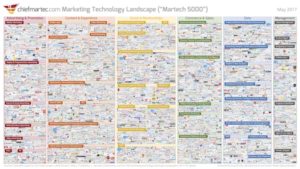After looking at the marketing tools available today, I’m both blown away and a bit overwhelmed by all the options. There are more than 5,000 technology solutions available today and as a marketer, I’m left wondering how can I best utilize all the latest disruptive technologies.
It can get a bit overwhelming watching the current MarTech landscape develop. According to the 2017 Marketing Technology Landscape, there are now 5,381 solutions available (up 39% since last year). You’ve probably seen the chart below, Marketing Technology Landscape (“Martech 5000”) put out annually by chiefmartec.com.
The MarTech Landscape
There are so many tools available for every facet of marketing – mobile marketing to optimization, account-based marketing to social media. However, one important question I often hear from my fellow marketers is, should I choose a single marketing solution that consolidates all the different tools or specialize each marketing tool by choosing the best option available in the current marketplace?
It’s actually a question I’ve been heavily contemplating the last few months and interestingly enough, also happens to be a common question many of our customers face. I wrote this blog to dive deeper into the pros and cons of both approaches and hopefully address what will make sense for you and your organization.
Consolidating Your Tech Stack
The real advantage of consolidating your technology stack is efficiency. With so many marketing tools available, managing individual vendor relationships, reports and data can seem daunting.
Solutions like HubSpot, Adobe, and Oracle have become more than just tools and have evolved into ecosystems. This consolidation amongst disparate tools can be appealing for marketers who aspire to have a single-view for all of their marketing facets.
Here are two reasons marketers choose a single-view solution.
1. More Holistic Approach
Choosing a single-view solution gives you the ability to manage all your data within one ecosystem. This can provide insights into what’s the most effective channel and make more informed decisions for customers. But there can also be product gaps within a holistic system that can lead to pieces of your martech stack not being fully optimized. Depending on your perspective, the one solution approach can be a good or bad thing for your marketing department.
2. Consolidation of data and relationships
The amount of marketing technology solutions also means a number of relationships that have to be managed. Some of the challenges that arise with managing different relationships include having to onboard new vendors so they have a clear understanding of your organization’s priorities. Some other challenges include ensuring both parties have an open line of communication and performance accountability.
Your company collects data on your customers through different sources; the majority of the time it’s through online channels such as social media, email, and website. Collecting all this data is valuable to your marketing team, sales, customer service, and other organizational functions as well. Having data consolidated into one single-view dashboard can help alleviate any gaps in reporting.
Specializing Your Tech Stack
If a company is looking to accomplish extremely strategic and specific objectives, they should look for individual technology solutions best suited to accomplish that one specific objective. The real advantage of choosing a vendor who specializes in one solution is the cumulated knowledge they have about their specialization.
By choosing a specialized vendor, you’re not only leveraging their expertise but also a differing approach to your overall marketing strategy. Similar to a board of advisors, these differing opinions can collaborate together and spot gaps in your process.
Here are two reasons why a company should choose marketing technology that has one specific focus/specialty.
1. Leveraging the Vendor’s Expertise
When you spread your marketing strategies across one solution, vendors tend to divide the attention and focus of their product offering while not fully focusing on addressing the specific challenges you’re trying to solve. For example, if you’re dividing your solution into social media management and content marketing analytics, you’ll have good tools for both, but neither would be the best-in-class solution.
A typical marketing tech stack of most companies may include:
- CRM
- Marketing Automation Platform
- Social Media Management
- Data & Analytics Platform
- Video Marketing
- Content Management System
By choosing a vendor for each specialization, you’ll diversify your technology stack, getting the best-in-class solution and leveraging the expertise of each specific vendor. Since technology integration is so critical today, ensuring each standalone solutions can speak to each other should be table stakes.
2. Eliminate the Features You Don’t Need
Having all the bells and whistles may seem appealing; however, having too many features can dilute the core value proposition of your technology. A product with a laundry list of features and functions isn’t an indicator of a great product as many of those features will be unnecessary and underutilized. A great product focuses on addressing the core challenge you’re trying to solve.
With the introduction of new features, all-in-one solutions will often increase their price. More times than not you’ll have to pay more for these additional features regardless of how much you’ll use them. By choosing a specialized vendor, you only pay for new features and updates that were designed to help solve that specific challenge.
Focus on Strategy, Not Technology
There are no limits to how many marketing tools will be available in the years to come. Implementing the latest cutting edge marketing technology can be exciting; however, it’s crucial to define the overall strategic approach for your tech stack first.
Your marketing technology stack is similar to a mechanic’s toolbox, there’s an assortment of tools at your disposal, but each specific job requires a specific tool. Having the right assortment will also help you identify gaps. You can’t loosen a lug nut with a hammer, you need a socket wrench.
Choosing the right technology needs the similar approach as every inclusion needs to have a clear purpose. Every tool should have a distinct objective and place within your overall stack. Whether it’s social media management or website personalization, leveraging specialized solutions for each is critical to the overall optimization of your stack and ability to achieve objectives.
Taking a strategic approach to your martech stack helps align tools to your process and ensures best-in-class technology so your marketing team can make smart data-driven decisions.





